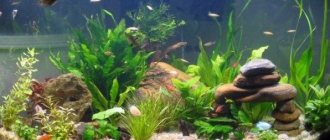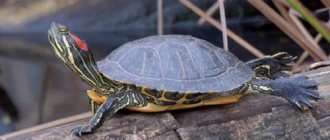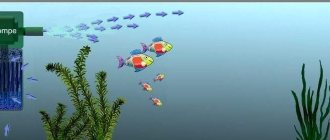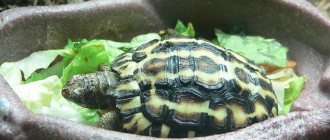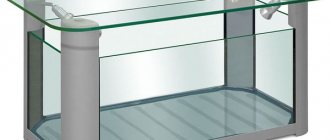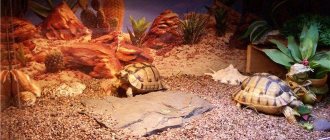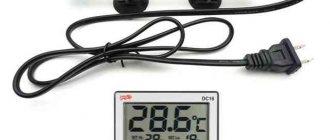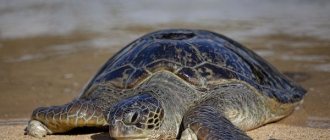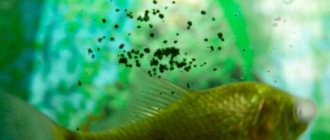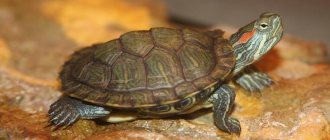Size and Shape Requirements
There are many varieties of turtles, both land and aquatic.
One of the most popular is the red-eared turtle. Typically, reptiles are kept in a special aquarium (terrarium) that has its own microclimate. It is a container of small height, most often rectangular in shape. The size of an aquarium for a turtle depends, first of all, on the size and number of reptiles. For a land turtle, an aquarium several square meters in size. meters is the best option. To keep 1 land animal not exceeding 15 cm, you will need a dwelling measuring 60x50x50 cm. For one large pet or 2 medium-sized ones, you need an aquarium of large dimensions with a length of 100 to 120 cm, a height and a width of 50 cm.
The size of the home for aquatic reptiles also depends on their dimensions, namely:
- small ones within 10 cm need a capacity of approximately 40 to 50 liters;
- for a 20 centimeter pet – from 90 to 120 l;
- for larger ones or 2 individuals - from 120 to 200 liters.
The shape of an aquarium for aquatic species should only be horizontal, where the length is greater than the width, since reptiles swim not deep into the tank, but along the length of the tank. For land turtles, the terrarium can be square.
Turtles have long begun to live in the same house with people. These creatures are unpretentious, love warmth, it is always interesting to watch them, study them, and at the same time they live for a long time, so you will have time to love them as a real pet. But a turtle cannot live on pure land; it needs a properly equipped aquarium. We will talk about designing an aquarium for turtles in this article.
First, let's decide what type of turtle you have decided to get. Their choice is not so large, but the most popular among all types of domestic reptiles is the red-eared turtle, so we will dwell on it and at the same time tell you how we equip an aquarium for the red-eared turtle.
Choosing an aquarium
It is best to choose an aquarium made of glass and only rectangular in shape, because... turtles swim not in depth, but in length. When choosing the size of the aquarium, you need to take into account that its size should be no less than one hundred liters per turtle. Don’t be fooled by the tiny baby turtles, because in fact, domestic species of turtles can grow even more than 30 centimeters, and the red-eared turtle, in rare cases, even up to a monstrous 60 centimeters. The size of the water layer should just cover the entire turtle along with its shell, so the water thickness in the aquarium should be at least 40 centimeters.
Island
Designing a turtle aquarium always begins with choosing an island for the reptile to sit on. This is the most important point, since if a turtle remains under water for a long time, it can choke. You can choose an island from a wide range of products presented on our website.
You can also build an above-water shelter for the turtle yourself: use any non-sharp stones and gravel and do not forget that the island should be located at an angle in the water; the turtle must somehow climb onto it. And remember that the island should not be very large, because the percentage of land for an aquarium with a turtle should be no more than 20 percent.
Water temperature
Although turtles are cold-blooded, warm water is one of the main conditions for their existence. Therefore, make sure that the temperature in your aquarium is always maintained at 22-26 degrees Celsius.
Light
The design of aquariums for the red-eared turtle and for other species of turtles necessarily includes 2 lamps: one ultraviolet lamp, which will replace the turtle’s sun rays and allow it to develop properly, and another is an incandescent lamp, which is needed to keep the turtle warm near it.
Aquarium background
In order for the aquarium to look as solid and pleasant as possible, you can decorate not only the back wall, but also the sides. You can choose any type of pattern and any colors that you like and decorate the walls of your aquarium with them, the turtle will not care about it. As a background, you can stick a special tile to imitate masonry or pieces of bark to the walls using silicone glue. This design always looks very impressive.
Plants
No landscaping or plants are usually used in aquariums for turtles, as they quickly eat them. Most often, plants made of durable plastic are placed around the perimeter of the aquarium and fixed either in pots, or pressed with special weights to the floor of the aquarium. And artificial vines can be placed on the islands.
Stones, shells, driftwood
A good decoration for any aquarium would be driftwood, noble species of trees: maple, alder, pine forest, but do not take oak, as they can decorate the water of the aquarium. We advise you to take snags from trees other than those that have lain on the soil in the forest, as they will release harmful substances into the water. It’s better to take those that have lain at the bottom of reservoirs - they are safe. When choosing various grottoes, stones and other components of “underwater architecture”, take into account the size of the turtle’s head so that it cannot get stuck in any cracks or holes. Any stones and decorations in the aquarium must be larger than the size of the turtle’s head, otherwise it will definitely try to swallow them.
Aquarium volume for a red-eared turtle
You need to approach the choice of an aquarium based on the size of your red-eared pet or (if you have a young individual) take it right away “for growth.” Keep in mind. that in a few years a tiny turtle the size of a peach pit will turn into an adult the size of a saucer.
The optimal size of the aquarium depending on the size of the turtle:
- babies from 3 to 10 cm – 50 liters;
- young turtles from 10 to 16 cm - 80 liters;
- large turtles from 17 to 25 cm – 150 liters;
- adult animals – from 150 liters.
In order to prevent the red ear from escaping, the top of the aquaterrarium should be closed with a lid that allows air to pass through well.
What plants can be used in a turtle aquarium? Let's look at their types.
Elodea
This plant can change color from dark green to light green, depending on the light and the amount of nutrients in the water. Elodea does not have a root system, so it does not take root and the presence of soil is not necessary for it. However, it can form aerial roots and grow both floating near the surface and along the ground.
With a lack of CO2, it is able to release it into the water on its own, which leads to a decrease in pH levels. It grows extremely quickly and consumes nitrate and nutrients dissolved in water.
Elodea is said to secrete a substance that inhibits the growth of blue-green algae.
Florida turtles and painted turtles love Elodea and will happily eat it, so it will not be possible to grow the plant with these species. Can be grown in an aquarium with a Mediterranean mud/musk turtle.
Our most common red-eared turtle will also not eat elodea (like most plants, since it is a carnivorous species).
Thai fern (Microsorium Pteropus)
Thai fern is rarely eaten by turtles due to its hard leaves. The plant is heavy, sinks to the bottom on its own, grows very slowly and requires low light. It does not require planting in the ground, but it will not float freely either.
Typically, the Thai fern is fixed in one place, tied to stones or driftwood. Over time, the bush grows, but young shoots may also appear on the leaves of the plant. Quite a hardy plant. Its homeland is the Philippines, Southern China and India.
Java Moss
Heavy plant, low light required for growth.
Turtles, as a rule, do not eat Java moss.
It can sink to the bottom on its own, but usually mosses are wrapped around driftwood or stones in order to achieve their fouling in the future. It has a tendency to grow profusely, so many people get rid of it over time, but with the help of Java moss you can make a wonderful rug in the form of a lawn, spreading it along the bottom. There is one drawback to this method - it will be difficult to “siphon” the soil to remove waste, so the lawn is not recommended.
May become entangled with other plants. A similar moss in terms of maintenance conditions is Willow Moss.
Hornwort (Ceratophyllum demersum)
The stem has branched leaves that form a floating mat and look like yarrow. The aquarium plant is very easy to care for, requires minimal lighting, but grows quite quickly in strong light.
Hornwort grows very quickly, even faster than elodea, and is good at absorbing waste from water. However, the plant is very fragile, the leaves break and clutter the aquarium with debris, so they often get rid of it.
Hornwort can be anchored in the ground, but it usually breaks free and floats on the surface. A large amount in the aquarium creates the effect of the Sargasso Sea.
Turtles can eat hornwort, but without much pleasure, so the plant can exist even in an aquarium with herbivorous turtles. It is also one of the few plants that can survive in a goldfish pond.
Red Ludwigia (Ludwigia repens)
Medium-sized plant, native to the USA. Ludwigia is planted in the ground. It can be green in color, and after planting it becomes red or tea-colored.
Turtles do not eat Ludwigia. It is quite beautiful, hardy, and grows quite quickly. Young shoots grow from the parent stem.
The plant requires moderate lighting (1 watt/liter of water). Turtles can dig up Ludwigia by burrowing in the soil, but it takes root easily and can even be left floating for several days.
A good choice for tanks with large volumes and with different types of turtles.
Duckweed (Lemna minor)
Tiny floating plant. Due to its rapid growth and absorption of waste, duckweed is often used for wastewater treatment, and the plant itself contains large amounts of protein.
In tanks without herbivores, duckweed forms a thick floating carpet, blocking the water from UV rays and causing the water to become cloudy.
In an aquarium with herbivorous turtles, the duckweed will soon be destroyed, because... This is quite a tasty treat for them. In small aquariums it can clog filters and cause problems. Duckweed is especially dangerous for waterfall filters and bio-wheel filters.
Water Hyacinth
A floating plant native to South America, where it forms dense, thick carpets (up to half a meter thick). It grows quickly and cleans water well, absorbing waste.
The roots of the plant are a favorite resting place for young mud/musk turtles in large water tanks.
Herbivorous turtles also eat water hyacinth. You should not have it in an aquarium that contains other plants - over time it will completely darken the aquarium from light and absorb all the air from the water.
Anubias species of all types
A plant with very tough, inedible leaves, requires little light and grows very slowly. In some species, such as Anubias nano, the rhizome cannot be completely buried in the ground, otherwise it will rot.
Anubias, like ferns, are often tied to stones with a thread. Their disadvantage is that the leaves are often covered with algae.
Crictocorynes of all species
A large group of fairly tolerant plants, with moderate light, resistant to various temperatures. Cryptocoryne has a large rhizome and is planted in the ground. Cryptocorynes are known for their dislike of frequent replanting. There are species with green and brown leaves.
Turtles do not eat Cryptocoryne, but they may trample, so it is preferable to plant the plant in aquariums with a small number of turtles.
Aponogeton of various species (Aponogeton)
A fairly hardy aquarium plant with a large rhizome, it reproduces by bulb. Grows in low light. Aponogeton has long green leaves.
Turtles do not usually eat aponogeton, but they may taste the leaves. These plants have a dormant period, so don't be surprised if your aponogeton suddenly drops its leaves.
Manufacturing materials
The material for making turtle aquariums is ordinary (silicate) and acrylic (organic) glass. Ordinary glass is more wear-resistant: unlike plexiglass, scratches do not form on it when cleaning the walls. It has lower thermal conductivity, which allows you to create the necessary microclimate. Reptiles often do not see glass and hit the walls.
Plexiglas is a plastic that transmits light well, is highly resistant to impact, and does not contain toxic substances. The weight of a plastic aquarium is almost 2.5 times lighter than a glass one. A large plastic non-toxic food container can also be used as a home for a turtle. For land pets, you can use a wooden terrarium.
Temperature
The recommended water temperature for the red-eared turtle is 23-28 °C. The temperature on a shaded (cold) island of land should be 23-25°C, and on a brightly lit (warm) area - 28-32°C. This is an absolutely ideal option for arranging the most suitable temperature conditions for the red-eared turtle.
To create such temperature conditions, heating is necessary. The main heating is carried out using a special lamp, which is fixed above one of the islands. If the temperature when heating with a lamp is insufficient, then additional heating is used.
You can use a heater in the form of a long glass tube that is immersed in water. Particular attention should be paid to its location: the turtle should not be able to accidentally bite the electrical wire or damage it with its shell.
Necessary equipment
Regardless of the type of turtle, each aquarium must be properly equipped. The reptile's home should correspond as best as possible to the natural conditions of its life. But the individual characteristics of the arrangement of its living space will depend on the type of turtle. Turtles are not very clean and pollute the water with food debris and excrement.
It is recommended to use a filter whose water throughput is 2 aquarium volumes per hour. In addition, the following equipment is required:
- regular incandescent lamp (40 W);
- ultraviolet lamp (UVB 5%);
- water heater.
You should allocate a place for feeding by placing a feeder.
For land-dwelling species, a small pond for swimming should be equipped in the terrarium. The decorative design of the home is also important: beautiful driftwood, stones and shelters are placed where the pet can retire and relax.
Filtration
The health of the turtle directly depends on the state of the water in the aquarium, so it must be kept clean. For a terrarium, it is better to use external aquarium filters of any type.
It is not advisable to install internal equipment, as it quickly becomes clogged with suspensions, losing efficiency.
The better the filter works, the less often a complete water change will be needed.
To maintain ecological balance, regular weekly replacement of half the volume of water is necessary. Before replacing, the water is allowed to settle.
Incandescent lamp
An ordinary incandescent lamp (an energy-saving lamp will not work) is installed above the island at such a distance that the air temperature above this area of land is 30-32 ° C. At night it is turned off.
Some owners of red-eared turtles neglect to install a UV lamp. However, this is a vital component of a reptile’s home. Its absence often leads to the development of diseases that can be fatal. Ultraviolet light is extremely important for the health of the red ear. It has a beneficial effect on metabolism, improves the condition of the reptile’s shell and skin, and helps the absorption of calcium. The UV lamp is placed at a height of at least 30 cm above the shore. It should burn for at least 2-3 hours a day.
We suggest you familiarize yourself with: Mini turtles for an aquarium, an overview of species with photos
Today you can purchase special lamps for terrariums with the required wavelength in almost any specialized store.
Where to buy an aquarium tank
A special aquarium is sold in specialized stores; you can also buy an aquarium secondhand, make it to order, or make it yourself. In other cases, you can get by with alternative options:
An ordinary horizontal glass aquarium - can be ordered or purchased at a pet store;
A large container made of food-grade non-toxic plastic – inexpensive, convenient, easy to clean;
Carrying for young animals - as a temporary housing for the young and if there is a container of suitable size.
What should the water be and how much should it be poured?
To keep a turtle comfortable, you need a swimming pool. The volume of water in it depends on the type of reptile. For land species, the depth of the reservoir should be only 0.5 times the height of the reptile’s shell. For the freshwater red-eared turtle and other aquatic species, a slightly larger volume is required, which would provide it with the ability to freely turn over with its shell down.
There should be no obstacles for the animal to swim in the pool.
You can use regular tap water for the aquarium, but you just need to let it sit for about 5 days first. This is necessary to evaporate chlorine from it. High chlorine content can cause eye and skin allergies in reptiles. Water should always be clean and fresh. There are water quality requirements such as:
- acidity (pH) in the range of 6–8, which corresponds to tap water;
- Water hardness can be any, but water with a higher carbonate content, a source of calcium, is considered more useful;
- optimal water temperature is 26–30 degrees; At lower temperatures, the red-eared slider and other aquatic species become lethargic and inert and may even refuse to eat.
A little about water filtration
The red-eared turtle can only live in clean water, but it itself produces a lot of garbage and waste, it likes to raise suspended matter, eats directly in the water, so the water cannot remain transparent and clean for a long time. To ensure cleanliness in the turtle's habitat, it is necessary to equip the aquarium with filters. It is worth choosing external models, since the internal ones become clogged very quickly and lose their effectiveness.
If you choose good filters, you can save yourself from the need for frequent cleaning and complete water changes. But in any case, you will have to replace about half the water volume weekly. It is worth adding water only after it has settled in room conditions for at least 24 hours.
Aquarium decoration
The main principle of choosing decorations is safety. Do not use items made from environmentally hazardous materials or with sharp corners or edges.
The soil for the bottom should not be very fine, as turtles can sometimes swallow it. Also, fine soil quickly becomes contaminated and is difficult to clean. It is better to use pebbles with a fraction of 5-6 cm.
For young turtles, you can plant green plants and introduce fish. Adults do not need soil, and they can eat or damage plants and fish.
In an aquarium with red-eared turtles, artificial plants made of plastic or silk would be appropriate. They are secured in the ground using weights. You can also install artificial vines on the islands.
To decorate the terrarium, you can use a variety of driftwood, grottoes, unusual stones and other elements. The driftwood should not be fresh, as it will release harmful substances into the water. It is better to take pieces of wood that have lain in the water of a body of water for a long time. The bark needs to be removed from them.
Tank selection
The aquarium must be suitable for the size of the turtle. It is worth starting from the breed characteristics of the species if your pet is still too small. Usually the male reaches 17 cm, and the female 20-21 cm. The tank should be spacious enough so that the reptile can move freely there without feeling restricted.
If we talk about volume, then an adult requires an aquarium designed for 150-200 liters, but if you buy a pair, immediately get a tank for 250 liters. Otherwise, the water will become polluted very quickly and become a breeding ground for bacteria that cause various diseases in turtles.
Sushi arrangement
Although the red-eared turtle lives and spends a lot of time in water, in addition to a pond, the aquarium must have dry land. Here the animal can breathe oxygen and bask in ultraviolet light. When equipping the shore, you should adhere to the following rules:
- the size of the coastal space should be 3–4 times the size of the pet; when keeping several reptiles, the total land area should be twice the number of individuals; ratio of land and shore – 20% to 80%;
- the surface of the shore must be non-slip;
- land areas should be placed in both illuminated and shady areas;
- the land should be quite high from the water level;
- coastal areas should be well fixed so that they can support the weight of the animal;
- It is strictly prohibited to use toxic materials to decorate sushi;
- for safe descent into and recovery from the water, the shore sections should be located inclined, gently descending to the very bottom of the pool; can be equipped with special ladders or ladders; steep slopes are strictly prohibited;
- the shore level should be 20–30 cm below the top edge of the aquarium so that the animal cannot escape from its home;
- to decorate sushi, medium and large pebbles or ordinary smooth pebbles are most often used, sealing them with aquarium sealant; It is not recommended to take small pebbles as a reptile may swallow them, which will lead to illness.
In addition to the shore, it is advisable to place islands on the water.
How to set up an aquarium for a turtle.
How to set up an aquarium for a turtle. Decorating an aquarium is very creative and interesting. After all, in the end it’s so nice to watch the beauty that you created with your own hands. Designing for fish will not be much of a hassle, but how to design an aquarium for a turtle?
Choosing an aquarium. For one turtle, as a rule, you need an aquarium with a capacity of at least 100 liters. This is worth taking into account, since turtles usually go on sale and are no larger than a matchbox, but they grow up to 30 centimeters or more.
Scenery. A prerequisite for decorating an aquarium for a turtle is the presence of an island. Despite the fact that this animal is not a land animal, it can still choke if it remains in the water for a long time. Such an island can be made from fine gravel, soil or earth, or you can simply buy it at the nearest pet store. The main thing to remember is that gravel and soil from land should not fall into the water. If you make land yourself, you need to take into account that it must be tilted so that the turtle can easily climb onto it.
Water temperature. When setting up an aquarium for a turtle, you need to take care not only of the design, but also of the water temperature, as this is very important for ensuring optimal living conditions for the pet. It is necessary to maintain the water temperature in the aquarium within 20-26C degrees.
When decorating an aquarium for a turtle, do not forget about special lamps. There should be two lamps in the aquarium: an incandescent lamp, where the turtle can bask, and an ultraviolet lamp, which promotes the full development of the reptile.
Background for an aquarium. In order for the back wall of the aquarium to take on a finished look, you can even cover the side walls with a background. The background can be either regular colors, such as grey, blue, green, brown or black, or with a pattern that matches the animal's habitat. The walls can be decorated with pine or oak bark. If you place them horizontally, you imitate rock formations; if you place them vertically, you imitate tree trunks. The bark is attached using self-tapping screws or waterproof glue. If the aquarium or terrarium is large and stable, you can attach special tiles that imitate masonry to the walls using silicone glue. This decor is very heavy. You can also find a large selection of background films in aquarium pet stores.
Aquarium landscaping. Landscaping in turtle aquariums is not necessary, as turtles may simply eat or break the plants. But you can use artificial plants, only made of durable plastic so that turtles cannot bite off a piece of them. You can place such plants in pots, on moss cushions, branches, or decorative elements.
Shells, driftwood, stones. Driftwood will be an excellent decoration in an aquarium. It is best to use dead hardwood branches. Suitable: willow, alder, maple and ash. All this can be bought at a pet store. Never use rotten or moldy driftwood. Pebbles and shells should be chosen based on the size of the turtle's head. Decorations should be about 2 times the size of your pet’s head so that the turtle cannot eat them. They should also not have sharp corners. Both rocks and shells should be washed in warm running water before being placed in the aquarium.
Share on social media networks
If you liked the article, share the link with your friends!
Note!
There are aquariums in which red-eared sliders cannot be kept:
- Small turtle tanks with a volume of up to 50-70 liters. They can only be used for temporary housing of animals. If a turtle lives in such a container for a long time, then it develops skin infectious diseases, dystrophy and softening of the shell.
- Aquariums in which the land is made of plastic.
- Aquariums in which it is impossible to set the desired temperature, as well as ultraviolet light and filtration. The absence of all these conditions leads to illness and death of turtles.
Thus, caring for a red-eared slider, like any other pet, requires some effort. But a terrarium in which the water is clean, the bottom is picturesque, and the animals are healthy is a fascinating sight that is worth the time and effort.
For the red-eared birds themselves, the soil in their home is not particularly important or necessary. Another thing is that owners usually try to decorate their pet’s habitat. Of course, the aquaterrarium should look aesthetically pleasing. But do not forget that not all materials are suitable for this purpose.
Large stones without sharp edges or pebbles at least 5 cm in size are suitable as soil. The reptile can swallow small pebbles, which will lead to serious health problems, and the sharp edges can injure the reptile.
In principle, it is not forbidden to use sand as soil. The only “but” is that cleaning an aquaterrarium with sand is not very convenient.
We suggest you read: Names for Scottish kittens for boys
Large shells will not only decorate your pet’s home, but will also saturate the water with calcium.
It is prohibited to use various plastic and glass pebbles for aquariums.
There is no point in planting plants in the red-eared home. Without thinking twice, your pet will eat them or dig them up. You can try decorating the aquarium with commercially available artificial plants, securely fastening them to the bottom. You can do without plants altogether by decorating the aquarium with various driftwood, unusual stones, etc. But keep in mind: you should only take driftwood that has been in the water for a long time. Fresh wood is not suitable.
An interestingly designed aquarium for red-eared turtles will add zest to any interior. But do not forget that when choosing decorations, first of all you need to think about the safety of your pet.
Testudines turtles
Snapping turtles Chelydridae The snapping turtle family includes two species belonging to independent genera. These turtles live in North and Central America. Snapping turtles have a small cross-shaped plastron and a very long tail, more than half the length of the body. The head, neck and tail are covered with small spiny scales. The dimensions of one of the species reach a mass of 30 kilograms with a shell length of 35 centimeters, the largest representatives of the second species weigh up to 60 kilograms with a shell length of 1.5 meters. Cayman turtles live in a wide variety of reservoirs, rivers, ponds, and lakes, preferring places with a muddy bottom that is easy to burrow into. The main food for them is fish, sometimes other small vertebrates are included in the diet.
Cayman turtles are kept in spacious aquariums with good water filtration. In captivity, they rarely grow to particularly large sizes, since growth depends on the size of the reservoir in which the animal is kept.
Aquatic turtles Emydidae
Freshwater turtles are the largest family of turtles, with 85 species classified into 31 genera. Representatives of this family live in Asia, Europe, North Africa, North and South America. The size of the shell varies from a few centimeters to 75 centimeters for the largest species, the batagur turtle. The carapace of these turtles is usually low and has an oval-round shape. Swimming limbs have a pronounced membrane and well-developed claws. The head and neck are usually covered with skin, only in some species small scutes develop on the back of the head. Most of the species of the family live in water, preferring bodies of water with slow currents. Many feel equally good in water and on land. Several species have switched to a secondary terrestrial lifestyle; these turtles have a fairly high shell. Freshwater turtles are primarily carnivorous, but some species have adopted a strictly herbivorous diet.
Freshwater turtles are kept in various aquaterrariums, depending on the biological preferences of the species.
Terrestrial turtles Testudinidae
The family has 10 genera and about 37 species. These are only terrestrial turtles that have perfectly adapted to life on land. The toes of testudinids are fused together, leaving only the claws free. The legs are very thick, resembling columns. The shell of terrestrial turtles is usually very high, although in some species it is slightly flattened. The head and legs are protected by powerful scales, often widened and enlarged. The sizes of land turtles range from 10 centimeters to 1.5 meters.
Land turtles are inhabitants of tropical regions. Most species are found only in Africa, others inhabit Southeast Asia and South America, and only a few species can be found in North America and Europe.
Representatives of this family inhabit predominantly arid biotopes, such as steppes, deserts, and savannas. Only occasionally can land turtles be found in forests and wet biotopes.
All testudinids are herbivores. This is an exceptional example of the development of plant food among turtles. Their food is green, lush vegetation, with which they receive the portion of water the body needs. In the habitats of many species, suitable food and water are available only during very short periods. In such places, turtles spend most of their lives (up to 8 months a year) in hibernation. Thanks to this slow metabolism, the life expectancy of land turtles is very long, up to 100 - 150 years.
Because of their slowness, when in danger they do not run away, but hide their head and legs in their shell. It is believed that at this time turtles practically cannot breathe, but the animal can calmly spend several hours in this position.
Land turtles make wonderful pets. Due to their slowness and non-aggressiveness, they are suitable for the most novice terrarium keepers, even children. It is necessary to feed turtles with lush green grass; in winter, you can use Beijing lettuce leaves in combination with a variety of vegetables and fruits. There are special mixtures for land turtles. Not only a terrarium is suitable for keeping turtles, but also a simple wooden box with a thick layer of sand, mulch or shavings on the bottom (depending on the species), however, all types of turtles require ultraviolet lighting and a lot of daylight. To create a comfortable environment for your pets, you can use fluorescent lamps with a high proportion of ultraviolet radiation.
Soft-bodied turtles Trionychidae
The family includes 22 species of turtles, grouped into 6 genera. They are common in Asia, Africa and North America. These turtles have a very strong reduction of the bony shell. The plastron is connected to the carapace by a soft ligament. The four limbs of turtles bear three sharp, powerful claws. Horny jaws are covered with soft leathery lips. In addition to the usual air breathing for reptiles, these turtles also have aquatic breathing. Soft shell turtles can absorb oxygen directly from the water. Soft-bodied turtles live in fresh water bodies, mainly in rivers. These turtles practically never leave water bodies and if they find themselves on land they never go far from the water. Soft-bodied turtles are active predators; they feed on fish, shellfish, and large arthropods. The most popular species for keeping, the Chinese trionix, reaches 30 centimeters in length.
Soft-bodied turtles are kept in aquariums with a thick layer of soil.
Mud turtles Kinosternidae
The family has four genera, uniting 25 species.
Mud turtles are common in a wide variety of water bodies in North and South America.
A distinctive feature of representatives of this family are the rib-like outgrowths of the cervical plate of the carapace, extending under the adjacent marginal scutes. Mud turtles are quite small, their carapace is rounded, with a weakly defined keel. The plastron of mud turtles consists of two halves connected by tendon ligaments, which allows them to close holes in the shell in case of danger. Developed membranes are noticeable on the paws of mud turtles.
These turtles feed mainly on animal food, although they do not refuse plant supplements to their main diet.
Mud turtles almost never come ashore. An aquarium with a volume of 50 - 70 liters, depending on the species, is ideal for keeping them. You can put soil in the aquarium and plant plants, but this is not at all necessary. And in order for the turtles to feel comfortable, it is necessary to place several shelters made of driftwood or flower pots at the bottom. The water temperature should be 22 - 26 degrees.
Mud turtles are very territorial; multiple males and turtles of noticeably different sizes should not be kept together.
Snake-necked turtles Chelidae
The family of snake-necked turtles includes 32 species, united in 8 genera. These turtles are common in South America, Australia and New Guinea. Representatives of this family are not able to retract the neck under the shell, so the neck and head are always visible from the front. Their plastron consists of 9 bony scutes, and in most species an unpaired cervical plate is developed in the carapace. The neck of these turtles is very long, for example, in the Australian snake-necked turtle, the neck and head are equal in length to the body. Most species of this family are rather inconspicuously colored. The matamata turtle has the most interesting appearance; its head and neck are covered with rows of scalloped skin flaps. Snake-necked turtles live in rivers and lakes and feed mainly on animal food.
Pelomedusidae
The family includes 19 species of five genera of turtles. Representatives of this family have a rather short neck, which, when in danger, is pulled back a little and then bent to the side. Using a combination of these movements, pelomedusae are able to completely retract their head and neck under their shell. Distinctive features from the closely related family of snake-necked turtles are the structural features of the plastron and carapace. The plastron always consists of 11 scutes, and the carapace lacks a cervical plate. The largest representatives of the family reach 80 centimeters in length. Pelojellyfish live in rivers and lakes, feeding mainly on animal food, although some species also eat aquatic vegetation.
Representatives of this family are kept in various aquariums and aquaterrariums.
Lighting and heating
To maintain a microclimate and stable temperature in the aquarium, it is necessary to use heating. The water is heated to the desired temperature (26–30 degrees) using a heater, which is immersed in the pool. To prevent your pet from being injured, the heater can be placed behind the aquarium decorations or covered with a plastic tube. Daylight is not enough for the reptile. To create comfortable living conditions, it is necessary to provide additional lighting.
An incandescent lamp (up to 60 W) should be installed above the shore, under the light of which the turtle will bask. You can use a special terrarium lamp with a reflector. The lamp must be placed at such a distance that the reptile cannot reach it and water splashes do not reach it.
Reptiles are animals whose body temperature is regulated by external sources. In their natural habitat, turtles are located either in the sun or in the shade as needed. Therefore, the aquarium also needs to provide for the presence of both an illuminated warm area and a cooler shadow area. To achieve this, a heating lamp is installed in the corner of the aquarium.
An ultraviolet lamp should also be placed for illumination. UV radiation takes part in the absorption of vitamin B, calcium and the production of vitamin D, which is necessary to strengthen the shell. UV rays also have a beneficial effect on the reptile's metabolism, skin condition and general well-being. However, the effect of ultraviolet radiation weakens as you move away from the lamp.
How to equip an island?
The red-eared turtle leads a sedentary lifestyle, spending a lot of time not only in the water, but also on the shore, so the aquarium must be equipped with at least one, or preferably several, land areas per turtle (one in a shaded place, and the other in a brightly lit, warm place ). On land, the turtle receives oxygen and enjoys UV rays.
What is important to consider?
- The land area should occupy at least a quarter of the entire bottom area.
- Land areas should have a sloping shore that smoothly rises from the bottom. Steep cliffs are not allowed. You can build a ladder or a mini-ladder, put a large stone or a grotto with gentle walls.
- The surface of the islands must be made of high-quality materials and be rough. If there is soil on the island, it should not crumble into the water.
- If there are several turtles, then the land must have such a total area that all individuals simultaneously have access to it and can fit.
- If there are several islands, then some of them may not be completely dry, but covered with water by several millimeters.
The island should be located approximately 30 cm below the edge of the terrarium so that the animal does not get out and run away.
Conditions for keeping the red-eared turtle
For the normal functioning of the animal, the following conditions must be observed:
- Water.
- Land.
- Temperature.
- Lighting.
- Use of ultraviolet lamps.
- Water filtration.
Interesting: How to determine the sex of a red-eared slider?
Water
In order for the turtle to swim freely and easily perform various maneuvers, the water level in the terrarium must be at least 40 cm. It should be changed once a week, but not completely, but only 30-40% of the total volume. Newly added water must first be left for 5 days.
Land
The red-eared slider is considered a swimming reptile . In addition to water, it can also be on land, crawling out to warm itself. This area should occupy 25% of the total area of the terrarium. The island should be attached to the base of the tank.
The top of the aquarium should be covered with glass with small holes to allow air to pass through. This is necessary to prevent animals from getting out.
The red-eared turtle is quite sedentary and spends a lot of time on land. You can arrange several islands for it. One may be in a shaded area, and the other in a brightly lit area.
Some points should be taken into account when arranging an island of land in a terrarium:
- A piece of land is made with a sloping shore, which should gradually rise from the bottom. It is not recommended to make steep cliffs.
- The island is made of high-quality material, and the surface must be rough so that the turtle clings to it with its nails and gets out of the water. You can place soil on it, but be sure to do it in such a way that it does not crumble into the water.
- If there are several red-eared turtles in the terrarium, then the area of the island is increased so that all the animals can fit on it.
- If there are several islands of land, it will be good if some are completely dry and others are slightly damp.
A piece of land is made 30 cm below the edge of the terrarium so that the animal cannot get out.
Temperature
The water temperature in the aquarium should be 23−28 degrees . If there are two islands of land, then one should be in a shaded place, and the temperature there should be 23-25 degrees. And on a warm island the temperature is usually 28-32 degrees. Such temperature changes are considered ideal for these animals.
Interesting: How do snakes mate? Mating Features
To create this temperature, use a special aquarium lamp. A drop in temperature below 20 degrees has a negative impact on the health of this pet.
Lighting and UV lamps
In their natural habitat, red-eared turtles often crawl onto land to bask in the sun's rays. Aquaterrariums also need lighting, so incandescent lamps of 40-75 W . The lamp must be hung above the sushi island. The distance from it to the lamp should be such that the air warms up to 28-32 degrees. At night the lights are turned off.
Many owners of red-eared turtles do not even realize that these pets urgently need ultraviolet light, which helps the body absorb calcium and synthesize vitamin D 3. Their lack contributes to the development of rickets and even the death of the animal.
You should purchase a UV lamp that emits UVB and UVA rays. It is strictly forbidden to use a lamp with UVC rays, because they burn the retina, making the turtle blind.
The UV lamp is turned on every day for 12 hours. It must be installed from above at a distance of at least 30 cm from the ground. Replace the lamp once a year.
Water filtration
The water in the aquarium should always be clean , then the turtles will not get sick.
External aquarium filters of any type are suitable for terrariums. It is better not to use internal filters, because they quickly become clogged with suspended matter, losing their effectiveness.
The better the filter, the less often you will need to change the water in the aquarium. To ensure that the water is always clean, it is changed every week by 30-40% of its volume.
Prohibited aquariums for turtles
The following aquariums should not be used for aquatic turtles:
Are you concerned about the health of your pet? We are responsible for those we have tamed!” - says a quote from the story “The Little Prince”. Maintaining the health of a pet is one of the main responsibilities of the owner. Take care of your pet by giving him the Vitatame complex. The unique complex is designed for cats and dogs, as well as birds and rodents. Vitatame active supplement will help your pet shine with health and share happiness with you!
- Having a volume of 50−70 liters. If a turtle lives in such a small space for a long time, then over time it develops infectious skin diseases, degeneration and softening of the shell.
- In which the sushi island is made of plastic.
- In which it is impossible to install lighting, ultraviolet lamps and filtration. Their absence leads to the death of turtles.
Thus, caring for a red-eared turtle is still not very easy. Only compliance with all conditions of proper maintenance makes the life of turtles long and happy.
Proper care
Aquariums are often covered with a lid with holes on top to prevent the turtle from getting out. But such ventilation does not provide sufficient fresh air. Poor aeration leads to air stagnation and accumulation of gases (especially carbon dioxide) emitted by reptiles at the bottom of the container. This leads to various diseases of the animal.
Therefore, additional flow aeration is so necessary. When arranging ventilation in aquariums for land turtles, the thermal convection method is used: cold air enters the aquarium through holes in the lower part of the walls, then, when heated, it rises and exits through the upper holes in the lid.
Ventilation can also control humidity, which depends on the number of inlets and outlets. Less humidity is achieved due to a large number of these holes, and more - due to a decrease in the number of both holes. To aerate the air in the aquarium of a red-eared turtle, in addition to a lid with holes, a compressor is usually used, which simultaneously fills air and water.
After creating favorable conditions, you should organize proper care for the reptile. It includes such aspects as balanced nutrition, caring for the animal itself and cleaning its home. The red-eared turtle, like all other aquatic species, is omnivorous. Until she reaches 3–4 years of age, she is fed mainly meat food. Starting from 4 years of age, when puberty sets in, the plant portion of the diet increases from 30 to 50%.
Only sea fish can be given. Plant foods are presented quite diversely, namely:
- plants for aquariums with the exception of elodea;
- indoor plants - tradescantia, aloe and thornless cactus, hibiscus;
- herbaceous plants - plantain, clover, dandelion;
- beet and carrot tops, lettuce leaves;
- various vegetables – bell peppers and cucumbers, carrots and zucchini,
- fruits - apples and pears, plums and bananas.
We suggest you familiarize yourself with: Peculiarities of feeding quails * Feeding devices * Basic feeding rules * Hatching of young animals
Caring for the red-eared reptile itself consists of cleaning its shell. Since it has nerve endings and is sensitive, you only need to clean the shell with a soft sponge.
The red-eared slider may shed frequently, causing the surface layer of skin to peel off. In this case, it is useful to bathe her in a warm chamomile decoction. Dried scales can also be carefully removed using cotton swabs. You also need to take care of your pet's home. It is necessary to monitor the cleanliness of the water in the pool. The water in it is changed frequently - up to 2 times a week. You can not change all the water, but only a third part to preserve the microflora of the reservoir.
The aquarium should be washed when the walls become dirty. To do this, first isolate the pet and drain all the water. Then the soil and accessories in the pool are washed well in clean water without detergents. Next, clean the walls of the aquarium with a wooden scraper without using cleaning agents. You can only use baking soda, after which the container should be thoroughly rinsed.
If there is no filter in the aquarium, then the water change is done more often: complete - once a week, and partial - after 3-4 days. Land turtles should also be kept clean. Since they like to burrow into the ground, they quickly become dirty. Therefore, they should be bathed regularly.
Wash them in warm water with the addition of soda at the rate of 1 teaspoon per liter of liquid, immersing them in water and leaving them in it for 20 minutes. Then, having taken out the turtle and allowed it to dry, wipe its skin with a swab moistened with olive oil. Of course, comfortable arrangement of living space and ensuring proper maintenance requires some material costs and labor investment. Therefore, before purchasing an exotic animal, you should consider all this.
How to start an aquarium for a turtle, see below.
Water and land in an aquaterrarium
Divide the entire space at the bottom into approximately three parts. Two should be on the water, and at least 20 cm should remain to the edge. The remaining third is dry land, where the turtle will bask and rest. Create an island-zone for her so that she does not have to climb too high and so that the reptile does not slide. As an option, they install a flat staircase with wide steps or a small improvised ladder. A large flat stone that is securely fixed to the bottom is suitable as an island - the turtle should not be able to turn it over. Do not place the stone too close to the wall of the aquarium and do not place it too high. Otherwise, the turtle may get out.
If the size of the aquaterrarium allows, then make two islands of different heights. Place one under the lamp, the second in the shade. If you have two turtles, then each should have its own sitting area.
At the bottom of the aquaterrarium, place soil - for example, pebbles with particles of at least 5 cm or just large stones. Pebbles and glass balls that are too small are not suitable, as large reptiles run the risk of swallowing them with negative consequences for the gastrointestinal tract. Sand or peat are also not suitable - they are uncomfortable for the turtle and difficult to wash. You can buy large artificial granules or calcined mineral blocks at the pet store - this is the best alternative to large pebbles.
Vegetation in an aquaterrarium with a red-eared turtle is completely optional. You can place something for beauty, but in the end your pet will simply chew it. For decoration, place a variety of driftwood, previously cleared of bark. Plastic vines and algae are suitable.
Take care of the cleanliness of the water in the aquaterrarium. It is extremely important for a turtle to be in clean water, which it quickly pollutes. Special filters will help maintain the cleanliness and transparency of the water environment. It is better to choose an external one, since the internal one is more of a hassle and will quickly become unusable. If you have a good filter, complete water changes can be done much less frequently. It is enough to fill it once a week with fresh water, pre-settled at room temperature for 24 hours - about half the volume.
